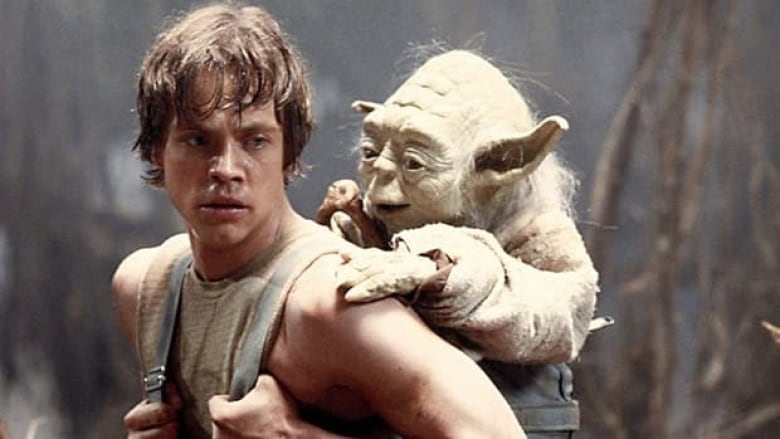According to This Reading There Has Been a Lot of Critical Review on Cambells Works
Information technology inspired movies like Star Wars, The Lion King, and The Matrix. It was named by Fourth dimension magazine as one of the 100 most influential books of all time. Joseph Campbell'due south The Hero With A Thousand Faces was published in 1949 — a book that is simultaneously timeless, and very much of its time. IDEAS looks at the massive influence of Campbell's theory.

* Originally published on September 3, 2019. Subconscious inside the plots of blockbuster movies like The Matrix and The Panthera leo King is a storytelling structure chosen the "hero's journey." That structure found its biggest success in the 1977 megahit,Star Wars, which was directly inspired by information technology. Only now some observers desire the hero to take a rest. The concept of the hero's journey was introduced in a book called The Hero With A Thousand Faces, published in 1949 past American professor, Joseph Campbell. The book argued that all aboriginal mythology tells one core story: the human psyche's evolution from child to adult, and ultimately to fully realized individual. Campbell went on to become a kind of stone-star intellectual, with public lectures, coffee table books and television specials. His piece of work besides found a home in Hollywood, especially after filmmaker George Lucas used the hero's journey theory as a model for Star Wars. In the moving picture, Luke Skywalker is young subcontract male child from Tatooine, whose journeying begins with a telephone call to adventure after he buys a pair of robots and discovers in them a hidden plea for help from Princess Leia. After he sets off on his quest, he undergoes a series of trials — featuring monsters, stormtroopers and a trash compactor — before rescuing the princess and destroying the Death Star. He eventually returns abode to a hero's welcome. Sean Hood, who teaches screenwriting at the University of Southern California, says that after Star Wars the hero's journey became a template for a money-making blockbuster. "When Star Wars makes a bazillion dollars, people want to know: what is its secret? And that's the shimmer of Joseph Campbell's work," Hood said. "It has this air of numinosity, it has this air of almost religious truth to it, and something vaguely special and sacred. And Hollywood eats that up. Information technology'south a great story." But Hood likewise has his suspicions nearly the hero's journeying equally Campbell has characterized it. Hood argues that at that place is something "very egotistical" well-nigh the hero structure. It places the protagonist at the center of the universe. "Everything depends on whether The 1 in The Matrix is going to be successful or not, the hero is going to save the world or not," he said. Hood explains that these kinds of stories give viewers a kind of "egotistical self-importance," and contrasts it with stories that have multiple points of views. "That kind of sophistication is important because otherwise movies just go to reinforce the sense that nosotros are the centre of the universe, and everything is virtually u.s.a.," he said. "That's, I think, the political danger. If everyone is thinking that they're the hero, then at that place'south no possibility of thinking with compassion from the point of view of other people who are experiencing completely different stories every bit y'all are." The Hero With A One thousand Faces was named past Time magazine every bit ane of the 100 most influential books of all time. Information technology's gone through countless reprintings and has been the field of study of idiot box specials, like the 1988 Bill Moyers series on PBS, "Joseph Campbell and the Power of Myth." Yet bookish mythologists aren't quite so enamoured past Campbell as his readers are. Keith Dickson, a professor of Classics at Purdue University, says Campbell'due south work gives people the wrong idea about the purpose of mythology. "Despite the pretense that these are aboriginal stories conveying what Joseph Campbell would telephone call 'boons from the transcendent deep,' these are basically stories that are told by those in power in gild to convince others that they should accept power." Dickson cites the story of Pandora's Box, the ancient Greek myth about the creation of adult female, which depicts women as bottomless containers of nothing just evil and despair. "Aboriginal Greek society considered women a threat to the integrity of families, a subject area of uncontrollable sexual desire," he said. "Urban Greeks tended to sequester their women, to lock them up." He says that in some cases, a myth can exist used to justify damaging social practices. "I call up my opinion of Campbell'south pretty articulate: I think he's a showman. I retrieve my stance about myth is pretty clear: I think myth does more harm than good. I think my proposal for the only effective response to myth being suspicion and critical analysis is likewise pretty clear." In the programme: Daniel Gorman Jr. is a Ph.D. student in Religious Studies at the Academy of Rochester Laurel Bowman is an Associate Professor in the Department of Greek and Roman Studies at the University of Victoria. Sean Hood is a screenwriter and Professor at the University of Southern California's School of Cinematic Arts Kim Hudson is the author of The Virgin's Hope: Writing Stories of Feminine Creative, Spiritual, and Sexual Awakening. Robert Segal is a Professor of Religious Studies at the University of Aberdeen Keith Dickson is a Professor of Classics at Purdue University ** This episode was produced by Matthew Lazin-Ryder. 


Dangers of the hero's journey


The myth about mythology
Source: https://www.cbc.ca/radio/ideas/how-mythologist-joseph-campbell-made-luke-skywalker-a-hero-1.5262649
0 Response to "According to This Reading There Has Been a Lot of Critical Review on Cambells Works"
Post a Comment